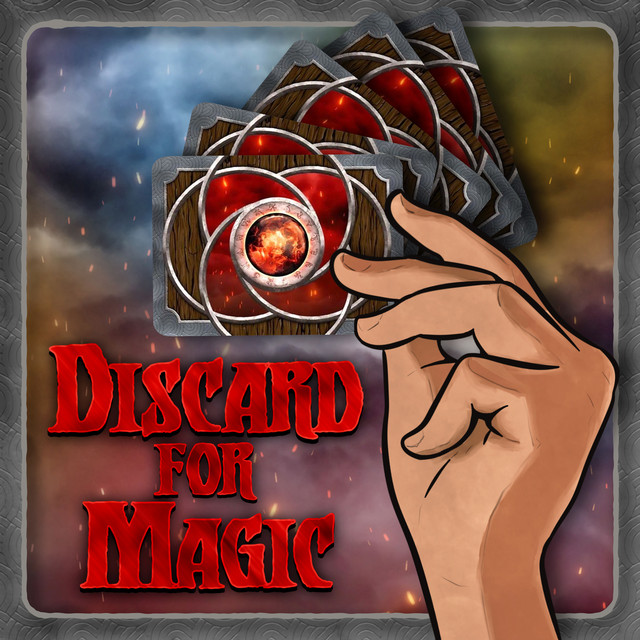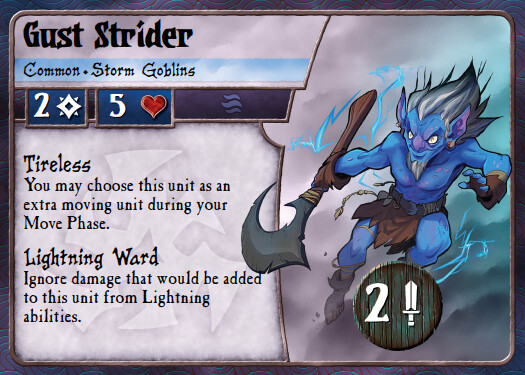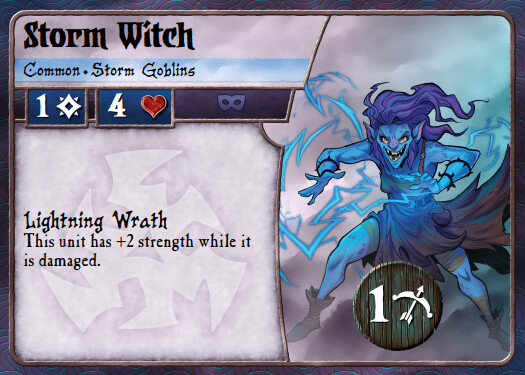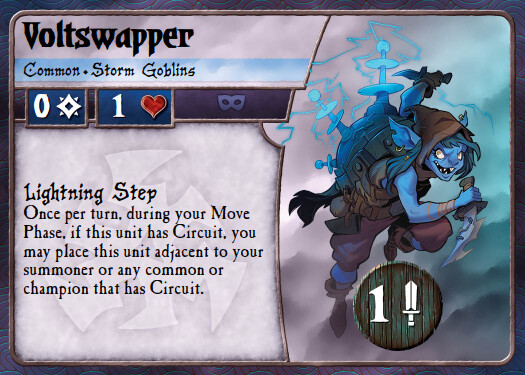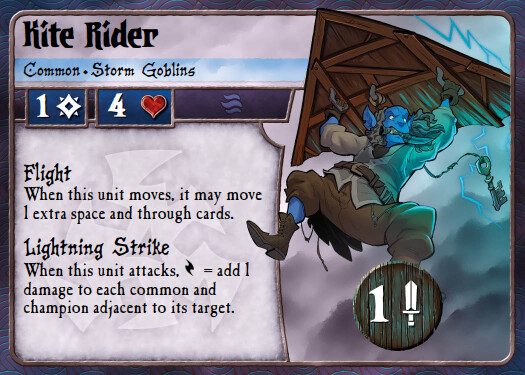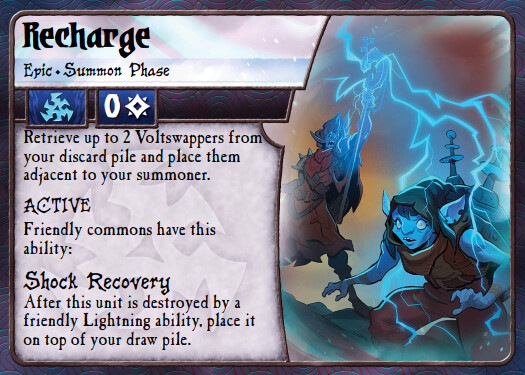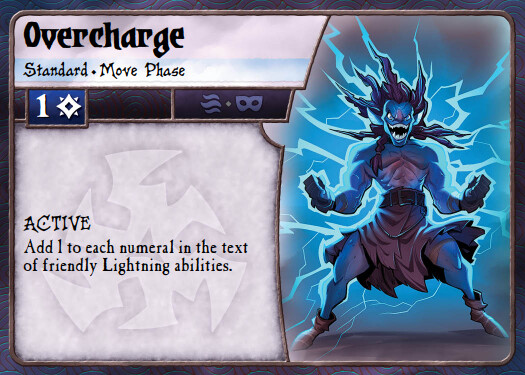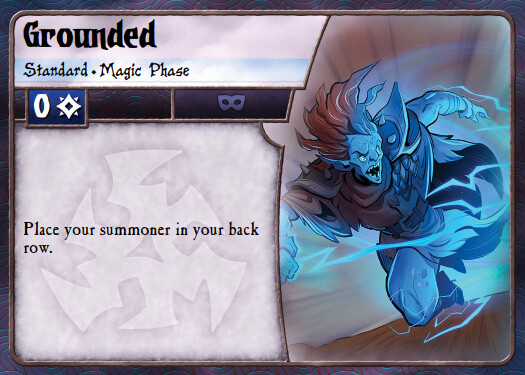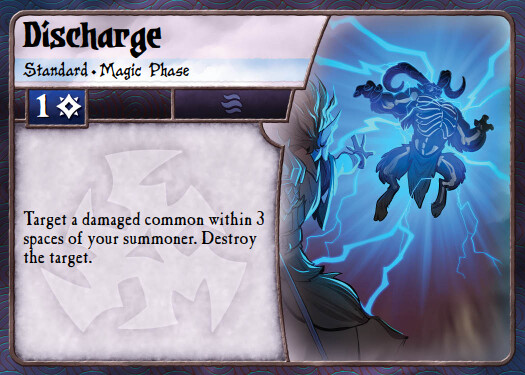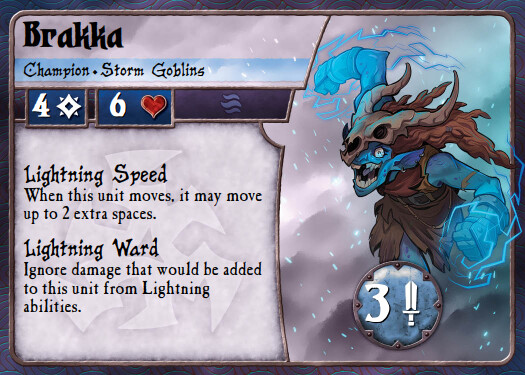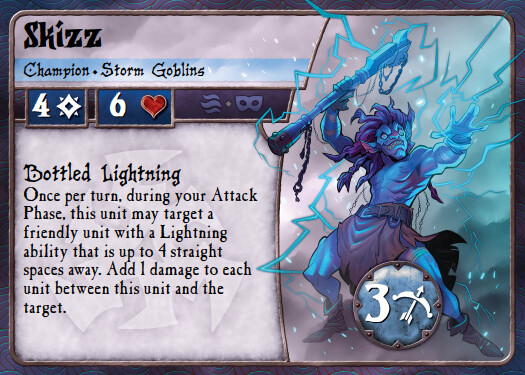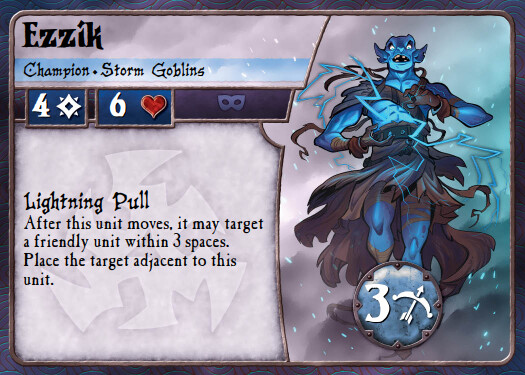
The Storm Goblins are a versatile faction specializing in board control and dealing significant damage to large groups of units. When the board becomes overcrowded, they excel at clearing it, and when sparsely populated, they leverage their strong poke abilities to chip away at the enemy Summoner or secure efficient trades.
A key strength of the Storm Goblins lies in their mobility, which enables them to consistently pressure the opponent's Summoner with Chain Lightning, wearing it down over time. This threat forces most Summoners into a highly defensive playstyle, allowing the Storm Goblins to dictate the positioning of their opponent's Summoner.

Thrak, the Summoner, contains the core of the deck: the Chain Lightning ability. This extremely powerful ability defines the Storm Goblins' tactics, allowing them to clean the board of threats and poke effectively. The faction's units and events are designed to maximize its effect on the opponent while minimizing its impact on the Goblins, often even creating a net positive. Notably, the ability has no cost, can be activated at any time during the attack phase, and only requires building a "circuit" to its targets.
The Storm Goblins' success largely depends on how frequently they can activate Chain Lightning. Opponents can disrupt this in two primary ways:
- Gates as Insulators
- Opponents often use gates strategically to separate units, making circuits longer and harder to complete.
- Focusing on Thrak
- Although Thrak can be anywhere in the circuit and can extend circuits with the right cards, over the course of the game, he must expose himself to connect. Poking Thrak can eventually make it too difficult for him to be part of the circuit, reducing Chain Lightning triggers and increasing the likelihood of losing.
Positioning Thrak requires skill. He aims to be as close to the opponent's Summoner as possible to create shorter circuits, but being closer also exposes him to danger. Gates are essential for both protecting Thrak and providing valuable summoning spots. Positioning Thrak near the opponent's Summoner while maintaining ample summoning options can help create efficient circuits that still connect to the Summoner.
Every common unit in the Storm Goblins faction plays a critical role, but the Gust Strider stands out as the most most core and reliable. Its high health, decent damage, and immunity to Lightning Ward make it a dependable connector. It also adds enough damage to finish off commons alongside Chain Lightning. Its Tireless ability ensures that having multiple Striders on the field is never a problem.
When board density is low, Thrak and Striders can form an efficient one-on-one team. With its stats plus Chain Lightning, a Strider can win most one-on-one battles. However, this strategy may leave Thrak exposed, which could be problematic.
The Storm Witch is the faction's best poking unit, thanks to its range and high health. Even with just 1 AV, it can poke at an opponent's gate to mitigate damage from inevitability. Its true power, however, lies in its synergy with Chain Lightning: one trigger gives it 3 Strength. For just 1 magic, you essentially get a 3-range, 3-strength unit, making it a solid investment.
While not the faction's core unit, Voltswappers are the key to major circuit turns. Their ability to connect the whole board and trigger Chain Lightning makes them a significant threat.
The flexibility of their Lightning Step ability, which can be activated, either before or after moving them, making it easy to place them exactly where needed - often without spending a move.
Voltswappers are deceptively cheap since they often die without giving magic to the opponent. This makes them useful not only for big circuit turns but also as efficient pokers. For instance, a Voltswapper can attack for 1 Strength, die to Chain Lightning, deal another damage, and open a path for a ranged attack. This sequence is a integral part of the Storm Goblins' poking arsenal.
Kite Riders provide additional flexibility and extend the Storm Goblins' reach. Their solid health allows them to block key summoning spots or strategically trap the opponent's Summoner.
While less essential than Voltswappers, Kite Riders offer versatility, providing extra reach and inexpensive blockers wherever needed.
The Lightning Strike ability is situational, with some marginal uses. For instance, it can be triggered by attacking a gate, but this might also damage the Kite Rider itself.
Recharge is an exceptionally powerful event that is a must-play in every game. Not only does it provide 2 Voltswappers, which already makes it a very good event, Shock Recovery offers great value. During Recharge turns, the strategy is to go all out, flooding the board with Voltswappers to create massive circuits. While there are occasions where you might use one Recharge just to get 2 Voltswappers, you should try to maximize your Recharge turns in every game, generally along with Overcharge.
Overcharge synergizes perfectly with Recharge and is the Storm Goblins’ most devastating combo. The main way to clean the board is Recharge into Overcharge. This combination is the biggest threat the Storm Goblins have, and opponents must respect it, or they might lose the game outright. Recharge + Overcharge deals massive damage for minimal cost. If the opponent has too many units on the board, this combo can clear it with relatively low investment, giving the Storm Goblins a significant edge. Always keep one copy in hand or in the deck to keep the opponent cautious. Once the opponent knows they don’t have to worry about this card, they can play more freely- something a Storm Goblins player doesn’t want since their main edge is the potential for damage to restrict the opponent’s actions.
This is a very straightforward event. As mentioned before, Thrak needs to push closer to the opponent’s Summoner, which is risky. Grounded gives Thrak the ability to be a little more aggressive, allowing you to push forward for an attack, create a short circuit, and then retreat to safety. It’s a versatile event, and you should aim to use at least one copy every game. If drawn early, it’s ideal for executing a quick hit-and-run with Thrak, letting you apply pressure without overexposing your Summoner.
Champions are not a key part of the Storm Goblins and serve more as auxiliary tools. The faction acknowledges this by making all three champions cost only 4 magic, allowing them to fit seamlessly into the Goblins’ strategy without disrupting their magic economy.
Brakka is the simplest of the three champions to use. Essentially a larger and faster Gust Strider. While it lacks Tireless, but makes up for it with increased speed making it a significant threat to enemy Summoners, and its extra damage is excellent for pairing with Chain Lightning. However, unless you need the extra movement speed or damage to handle a 4-health target, Gust Striders are generally more efficient. Still, the 4-move speed of Brakka makes it a massive threat in a faction that excels at poking Summoners.
Skizz is a general-purpose champion with the highest damage output in the faction, especially at range. To maximize its impact, you need to position Voltswappers or Kite Riders behind targets, which can be challenging. Skizz works well on both empty boards, where it can poke effectively, and full boards, where it can deliver significant damage. Ultimately, Skizz provides significant firepower, but its damage can be difficult to set up properly.
The Storm Goblins' strategy revolves around creating efficient circuits between Thrak and the opponent's Summoner. Shorten the circuit, poke consistently, and use events like Recharge and Overcharge to clear the board.
However, if the opponent disrupts these circuits or forces Thrak into hiding, making the circuits too long, the Goblins lose their advantage. Success with this faction depends on how well you can balance creating circuits and minimizing risks.
Copyrights for the Summoner Wars logo and art belong to Plaid Hat Games,
used herein with their express permission.

